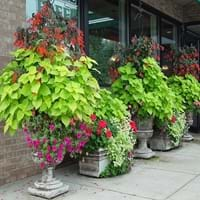Life Span
Perennial
Annual and Perennial
Type
Grass
Bulb or Corm or Tuber
Origin
Hybrid origin
Central America, South America
Types
Alta fescue, Kentucky fescue
Vine, Flowering plant
Habitat
meadows, Well Drained, yards
All sorts of environments, Along Railroads, Banks, Moist Ditches, Roadsides, rocky banks of streams
USDA Hardiness Zone
5-8
10-13
Sunset Zone
A1, A2, A3, 1a, 1b, 2a, 2b, 3a, 3b, 4, 5, 6, 7, 8, 9, 10, 14, 15, 16, 17, 18, 19, 20, 21, 22, 23, 24
21,22
Habit
Clump-Forming
Vining/Climbing
Flower Color
Pale White
Purple, Rose
Flower Color Modifier
Bicolor
Bicolor
Fruit Color
Non Fruiting Plant
Not Available
Leaf Color in Spring
Blue Green
Purple, Dark Green, Black
Leaf Color in Summer
Light Green
Light Green
Leaf Color in Fall
Blue Green
Several shades of Green
Leaf Color in Winter
Green, Tan
Light Green
Leaf Shape
Grass like
Acicular
Plant Season
Spring, Fall
Spring, Summer, Fall, Winter
Sunlight
Full Sun, Partial Sun
Full Sun, Partial Sun
Growth Rate
Fast
Very Fast
Type of Soil
Clay, Loam
Clay, Loam, Sand
The pH of Soil
Neutral, Alkaline
Acidic, Neutral, Alkaline
Soil Drainage
Average
Well drained
Bloom Time
Not Available
Late Spring, Early Summer, Summer, Late Summer, Early Fall, Fall, Late Fall
Tolerances
Not Available
Drought
Where to Plant?
Ground
Container, Ground
How to Plant?
Seedlings, vegetative cuttings
Cuttings, Leaf Cutting, Tuber propagation
Plant Maintenance
Medium
Medium
Watering Requirements
Allow to dry out slightly between watering, Never Over-water
Keep the Soil well drained, Needs very little water
In Summer
Lots of watering
Lots of watering
In Spring
Moderate
Moderate
In Winter
Average Water
Average Water
Soil pH
Neutral, Alkaline
Acidic, Neutral, Alkaline
Soil Type
Clay, Loam
Clay, Loam, Sand
Soil Drainage Capacity
Average
Well drained
Sun Exposure
Full Sun, Partial Sun
Full Sun, Partial Sun
Pruning
Prune after flowering, Prune for size control, Remove dead or diseased plant parts
Remove damaged leaves, Remove dead branches, Remove dead leaves
Fertilizers
All-Purpose Liquid Fertilizer
All-Purpose Liquid Fertilizer
Pests and Diseases
Brown patch, Gray leaf blight, Pythium blight, Rust, Zoysia patch
Red blotch
Plant Tolerance
Full Sun, Heat And Humidity
Drought
Flowers
Insignificant
Showy
Flower Petal Number
Single
Single
Foliage Texture
Medium
Coarse
Foliage Sheen
Matte
Matte
Attracts
Mealybugs, Mites
Aphids, Beetles, Cutworms, Insects, Mites, Whiteflies
Allergy
Skin rash, Vomiting, Watery eyes
Abdominal pain, allergic reaction, Nausea, Skin rash, Twitching of face
Aesthetic Uses
Ground Cover, Used in parkland
Not Used For Aesthetic Purpose
Beauty Benefits
Not Available
Not Available
Environmental Uses
Fixes Nitrogen, Prevent Soil Erosion
Air purification
Medicinal Uses
Antispasmodic
Cures constipation, Fiber, Low calories, lowering blood pressure, Potassium, ß-carotene, Vitamin A, Vitamin C
Part of Plant Used
Whole plant
Leaves, Root, Shoots, Stem, Tuber
Other Uses
Animal Feed, Used as Ornamental plant
Starch, Used As Food, Used as Ornamental plant
Used As Indoor Plant
No
Sometimes
Used As Outdoor Plant
Yes
Yes
Garden Design
Groundcover, Lawns and Turf
Container, Edible, Groundcover, Hanging Basket, Herb / Vegetable, Mixed Border, Rock Garden / Wall, Vine
Botanical Name
Festuca arundinacea
IPOMOEA batatas 'Blackie'
Common Name
Tall Fescue
Blackie Sweet Potato Vine, Sweet Potato Vine
In Hindi
tall fescue
शकरकन्द
In German
Rohr-Schwingel
Süßkartoffel
In French
Festuca arundinacea
Patate douce
In Spanish
Festuca arundinacea
Ipomoea batatas
In Greek
tall fescue
Sweet potato
In Portuguese
Festuca arundinacea
Batata-doce
In Polish
Kostrzewa trzcinowa
Wilec ziemniaczany
In Latin
tall fescue
Ipomoea batatas
Phylum
Magnoliophyta
Tracheophyta
Class
Liliopsida
Magnoliopsida
Order
Cyperales
Solanales
Family
Poaceae
Convolvulaceae
Clade
Angiosperms, Commelinids, Monocots
Angiosperms, Asterids, Eudicots
Tribe
Not Available
Not Available
Subfamily
Not Available
Not Available
Number of Species
Not Available
Not Available
Season and Care of Tall Fescue and Sweet Potato Vine
Season and care of Tall Fescue and Sweet Potato Vine is important to know. While considering everything about Tall Fescue and Sweet Potato Vine Care, growing season is an essential factor. Tall Fescue season is Spring and Fall and Sweet Potato Vine season is Spring and Fall. The type of soil for Tall Fescue is Clay, Loam and for Sweet Potato Vine is Clay, Loam, Sand while the PH of soil for Tall Fescue is Neutral, Alkaline and for Sweet Potato Vine is Acidic, Neutral, Alkaline.
Tall Fescue and Sweet Potato Vine Physical Information
Tall Fescue and Sweet Potato Vine physical information is very important for comparison. Tall Fescue height is 5.10 cm and width Not Available whereas Sweet Potato Vine height is 15.00 cm and width Not Available. The color specification of Tall Fescue and Sweet Potato Vine are as follows:
Tall Fescue flower color: Pale White
Tall Fescue leaf color: Blue Green
Sweet Potato Vine flower color: Purple and Rose
- Sweet Potato Vine leaf color: Purple, Dark Green and Black
Care of Tall Fescue and Sweet Potato Vine
Care of Tall Fescue and Sweet Potato Vine include pruning, fertilizers, watering etc. Tall Fescue pruning is done Prune after flowering, Prune for size control and Remove dead or diseased plant parts and Sweet Potato Vine pruning is done Remove damaged leaves, Remove dead branches and Remove dead leaves. In summer Tall Fescue needs Lots of watering and in winter, it needs Average Water. Whereas, in summer Sweet Potato Vine needs Lots of watering and in winter, it needs Average Water.





